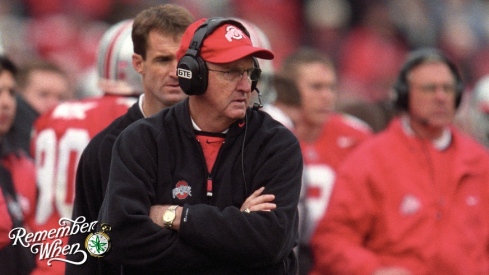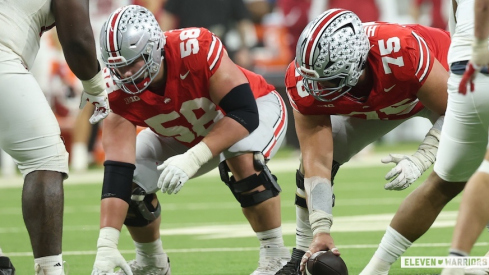
Ohio State's otherwise solid defensive performance against Central Florida was marred by allowing multiple explosive plays (+20 yards) that permitted UCF to compile several scores. While much of the focus has been upon the Buckeye pass rush (or lack thereof), the biggest impediment to the OSU defense is blown coverages and poor tackling that are giving opposing offenses the opportunity to score points. This, first and foremost, is what Ohio State must fix.
The Rush Part I: To every action there is an equal and opposite reaction
Let's get down to brass tacks and immediately address Ohio State's pass rush, both in terms of scheme and personnel. A lot of sturm und drang—including from Urban Meyer—has focused upon the Buckeye pass rush. This concern is exacerbated by the belief that Ohio State's defensive line is the team's strength. So what is wrong with the OSU pass rush?
The first point that must be made is in regard to game theory. SmartFootball's Chris Brown had a great post where he discussed run/pass balance, making the counterintuitive point that a team may end up passing more when they have a great tailback for the simple reason that defenses are committing more defenders to stop the run. This of course works both ways. In its first week, Central Florida lined up under center and played power football. Against Ohio State, by contrast, UCF was entirely in shotgun, focusing a high percentage of their plays on the quick game while simultaneously using six and seven pass blockers. Why are they doing this? Well, as George O'Leary stated:
“Ohio State's front seven is outstanding,” he said. “John Simon is as good as anyone in the country. You don't want to take your time passing against them. The quarterback can't take more than three- or four-step drops.”
This was not simply coachspeak. UCF generally kept one to two potential receivers in to block. In particular, the Knights constantly chipped and double-teamed Simon with a RB or TE.
One would not expect an offense to react in this manner to a defensive line (and pass rush) they did not respect. Opposing coaches clearly respect the Buckeye pass rush enough to where they are limiting their options because of it, which means it is already an effective asset.
The Rush Part II: Whither the Scheme
The Buckeyes employed two different defensive lines. In base 4-3 under situations, the Buckeyes operated with John Simon (Viper), Tommy Schutt (3-Tech), Garrett Goebel (NG), and Johnathan Hankins (5-Tech). Ohio State played their under to the field (rather than formation), prompting UCF to often put their strength into the boundary. From the nickel, OSU generally played with the following: Noah Spence (Viper), Adolphus Washington (3-Tech), Hankins (NG), and Simon (5-Tech). Steve Miller also played extensively at Viper in the second half.
Ohio State responded primarily with nickel to UCF's 'spread' personnel. OSU plays two fronts with their nickel. They play the 4-2-5 over in medium situations. In must-pass situations, the Buckeyes play a 30-odd front head up on the center and tackles with the 'Viper' roaming.

The Buckeyes prefer to run zone blitzes from their odd front. It is also where they (infamously) rush three and drop eight. Two points on that. The first is for those that philosophically disagree with rushing three (and I am generally not a fan): they have to grapple with the fact that two of the Buckeyes' three interceptions Saturday were when OSU dropped eight. In these situations it worked exactly as designed—the QB had to try to force the ball into tight windows and was unable to do so.
The second is how often did OSU actually rush three. We all suffer from availability bias as we watch the game, wherein defining events will stick with us. This is why film review is so helpful. Dvo45 helpfully compiled the statistics of the Buckeye rush numbers against UCF. Here are the results:
- 3 Man Rush: 6 Times
- 4 Man Rush: 28 times
- 5 Man Rush: 9 times
- 6 Man Rush: 2 times
The most oft-combination from the 30 front, as seen in the first video, is to use some type of zone blitz combination with one or more of the stand-up defenders.
The Rush Part III: The Upshot
The upshot is that while the Buckeye pass rush can certainly improve, it is not as dire as some believe. For starters, the fact that offenses are limiting themselves to dealing with the perceived threat is in itself an accomplishment because the Buckeyes have already taken away some of the opposing team's options. Personnel-wise, Ohio State is looking for a combination that can get pressure with four, particularly if Simon faces double-teams, as noted above. Hankins elevated his level in the second half—he began popping off the screen as beating his man—and that needs to continue. Miller, Washington, and Spence have all flashed at times but are young and just need to put it together consistently. OSU's coaching staff does face a balancing act, however, in that their best pass rushers are not their best defenders against the run. So if they go too far in only concerning themselves with a pass rush, it can dissipate the defense's best attribute, which is shutting down the run game. The return of Nathan Williams and Michael Bennett will help in this regard. Both are more well-rounded at this point then their younger counterparts, particularly Williams.
An additional problem OSU has faced is that when they have blitzed, the blitzers have had little success getting to the quarterback. Instead, they have allowed themselves to be blocked by blitz pick-up running backs. OSU is thus getting little marginal utility from additional rushers, which needs to improve.
Schematically, the upshot is that the rush, both schematically and personnel-wise, is not as passive as some feared. Indeed, I came into the review thinking that OSU needed to zone blitz more on third down, but they are doing so quite often. Nonetheless, some simple steps could assist in creating pressure without fundamentally changing the defenses' persona. The defensive line can stunt and twist. In pass situations where there is less concern for gap responsibility, this can help free defensive linemen and not allow the offensive line to get into a groove without changing the number of rushers. OSU also needs to be more strategic about whom they blitz. Finally, the OSU coaches must pick and choose their spots to use an 8-man zone. This zone's benefit is in medium situations where the offense has to force the ball into tight spots. It is unhelpful on third and long, where the offense needs to advance the ball vertically and having a fifth underneath defender does not change the deep arithmetic.
Occam's Razor applied to the Ohio State Defense
The heightened focus upon Ohio State's pass rush is in some ways warranted but also misses the point. Not to be too obviously reductive, but the purpose of defense is to prevent the offense from scoring points. One area that increases an offense's chance of scoring is plays of 20+ yards. Allowing nearly ten such plays through two games has been the single biggest contributing factor to points allowed. While the pass rush has not helped prevent such plays, it is not the primary cause. Instead that can be attributed to 1) poor pursuit angles and tackling and 2) blown coverages.
For instance, UCF's first scoring drive was aided by two such explosive plays. Both were permitted by the Buckeye defense's poor fundamentals. The first was a simple screen pass where C.J. Barnett misses a straightforward tackle.
The second is a sweep where the running back is able to gain the edge due to poor angles by Ryan Shazier and Christian Bryant, who both get caught in the wash.
These are basic fundamentals that will hold any defense back from achieving their potential.
Similarly, OSU has simply had too many coverage breakdowns—particularly in the deep third—to not cause concern. For instance, here OSU is playing cover 4. But Bradley Roby bites on the inside post, which is clearly not his responsibility in this coverage.
On the goal line, neither Bryant nor Shazier maintain their responsibility for the releasing tight end, resulting in an easy touchdown.
Bringing it all Together...
Perhaps nowhere were all these issues more prevalent than on the 3rd and 21 play that UCF converted for a first down. UCF kept in seven blockers but Ohio State only rushed three and thus produced no pressure on the quarterback. But the most acute issue was that Ohio State utterly failed in running a cover-3 defense. Roby follows the post route, vacating his third and allowing the corner route to come open behind him while three underneath Buckeye defenders look on.
This play is axiomatic of the issues discussed above. The three-man pass rush does not create a play and the extra underneath defender is unnecessary. But the most immediate cause of the big play is a simple blown coverage that should not occur.
And Going Forward...
The hyper-focus on the pass rush thus may be overstated. The pass rush can and should be improved, both through getting the right personnel and scheme tweaks. Yet the pass rush is not the primary concern for the Buckeye defense. Instead, the defense has performed well absent giving up big plays, which have been caused by a breakdown of fundamentals. One helpful sign from UCF was the play of Ohrian Johnson at the 'star.' Meyer made clear he wanted Johnson on the field, and his faith was rewarded by stellar fundamental play in the underneath curl to flat zone.
But in sum, it is the back seven that must correct and improve upon these issues for the defense to reach the next level.

